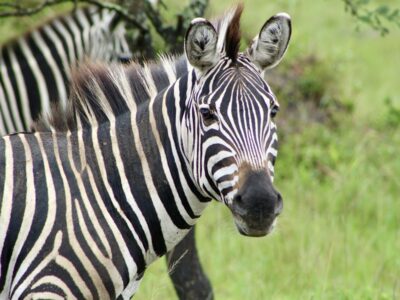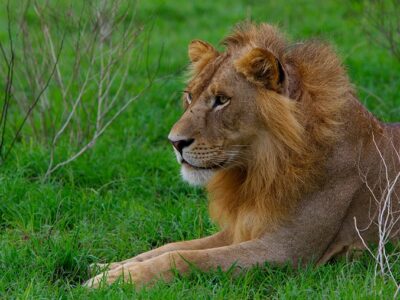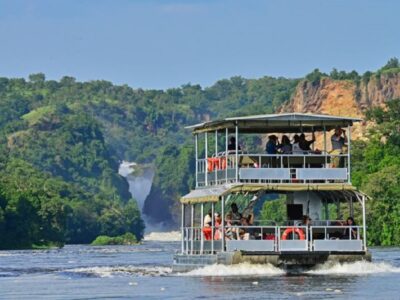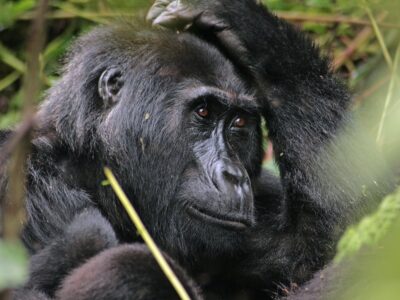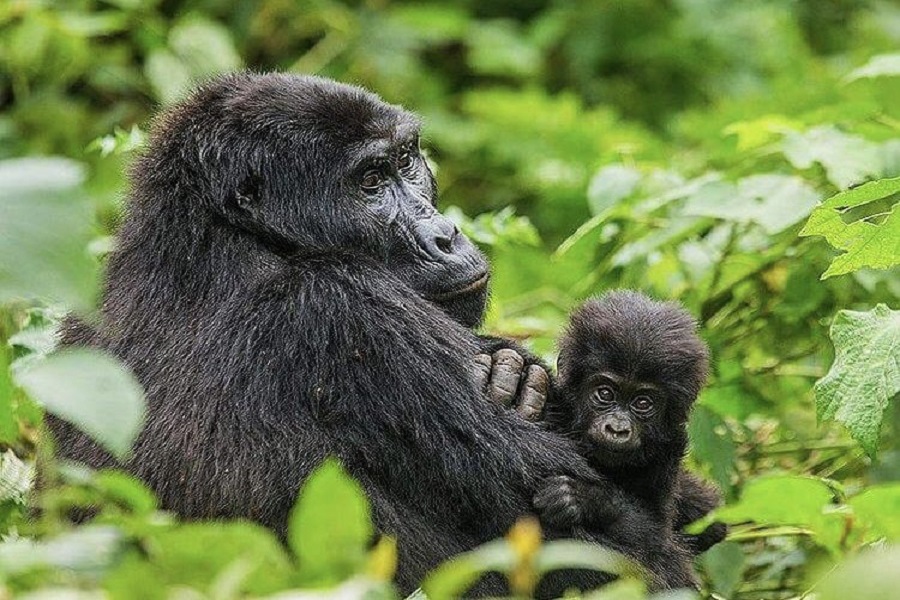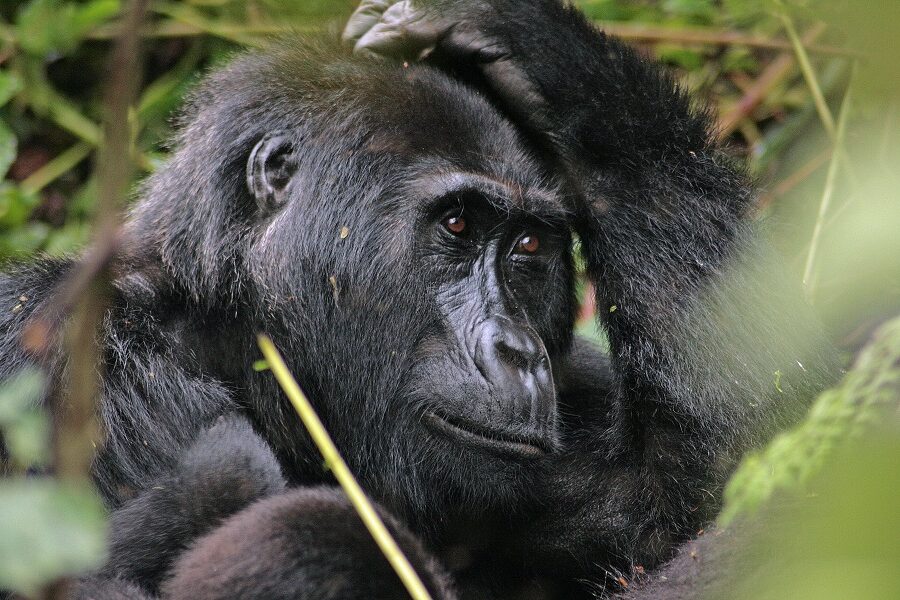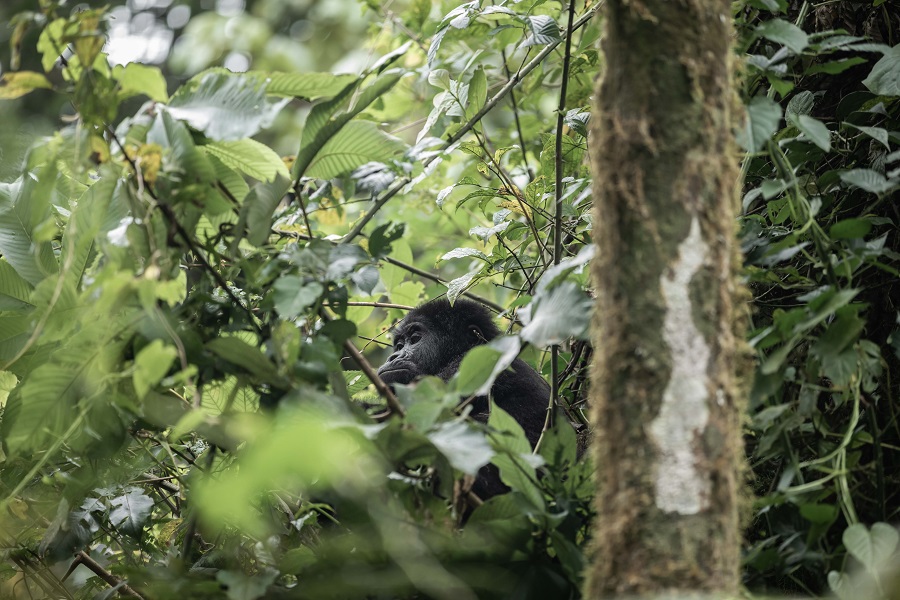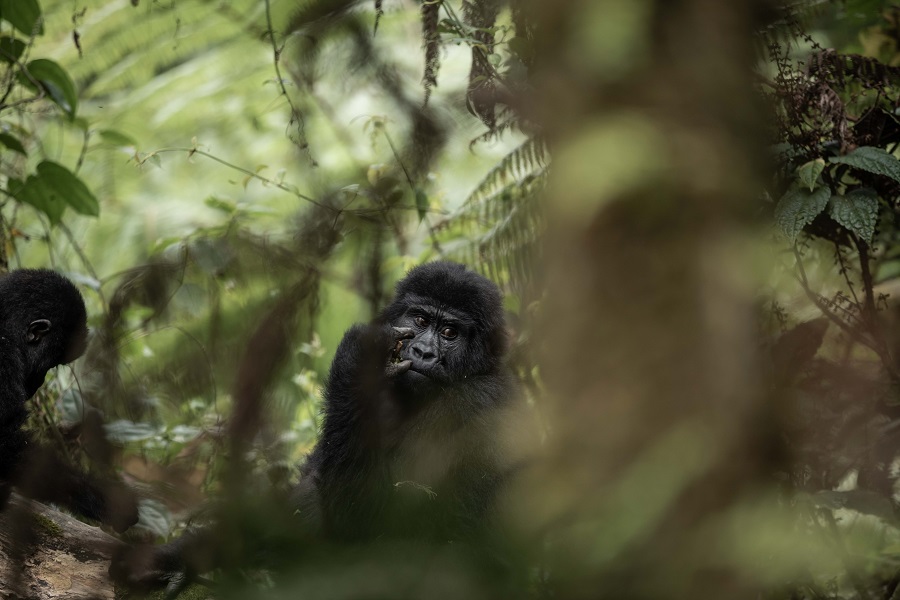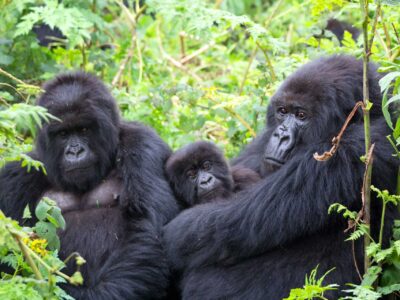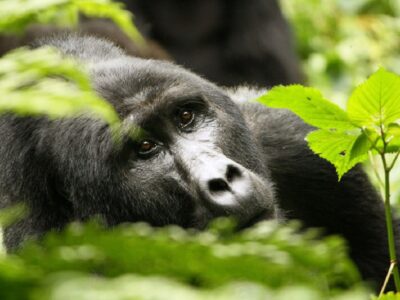Bwindi Impenetrable National Park
This park is home to more than half of the world’s wild mountain gorilla population and was declared a Natural World Heritage Site in December 1994. World Heritage Sites are internationally recognized as natural features of outstanding beauty or scientific value.
The landscape here is rugged, with deep valleys running between steep sided hills and ridges with barely a square kilometer of the park flat. There is a blend of both lowland and montane rainforest with a dense undergrowth of herbs, vines and shrubs (hence the name impenetrable).
This area is regarded as one of the most biologically diverse forests in Africa with the richest faunal community in East Africa. There are estimated to be 120 species of mammals (more than any other national park in Uganda except Queen Elizabeth) and is the only park where chimpanzees and gorillas co-exist together. There are an estimated 360 species of birds, including 23 localized species found only along the Albertine Rift Valley and 14 found nowhere else in Uganda.
The pristine rainforests of this park, one of the largest natural forests in East Africa, are home to approximately 300 species of butterfly (including two endangered species of swallowtails), 200 native tree species and many species of reptiles and amphibians (including one species of frog that may be new to science).
The rugged terrain makes gorilla trekking strenuous work and visitors should be prepared for up to 8 hours of hiking (good physical condition is a must).
| Languages spoken | English, Germany, French, Swahilli, Spanish, Chinese |
|---|---|
| Currency used | UGX / USD / GBP / EURO |
| Area (km2) | 321 |
| Country name | Uganda |
Things To Do
Bwindi is a true definition of a thick tropical rain forest that inhabits some of the world's rare bird species, tree species, and above all its home to the hald of teh remaining Mountain Gorillas in the world. Birding, Mountain Gorilla Tracking, Long Day Forest Hikes and community Encounters are among the unique things that you can do while at Bwindi.
GORILLA TREKKING
Bwindi Impenetrable Forest National Park is best known for mountain Gorilla populations and gorilla tracking activity, but it also provides refuge to elephant, chimpanzee, monkeys and various small antelope and bird species. If you book a Uganda safari without Gorilla trekking then you will have missed an opportuinity to see these rare and threatened gorillas. The variant biodiversity is supported by the fact that Bwindi is extremely old and also its slopes extend over a broad altitudinal range of 1447m above sea level, enabling habitats ranging from lowland forest to Afromontane vegetation that encourage life sustainability of these forest inhabitants.

With its slang “ The ultimate Gorilla experience” Bwindi Impenetrable Forest National Park also offers some of the finest montane forest birding in Africa and is a key destination for any birder doing a Safari to Uganda. Amongst the numerous possibilities are no fewer than 23 of Uganda's 24 Albertine Rift endemics, including spectacular, globally threatened species such as Shelley's Crimson wing and the African Green Broadbill. Bwindi is one of the few in Africa to have flourished throughout the last Ice Age and it is home to roughly half of the world's mountain gorillas.
You can as well decide to combine your gorilla tracking activity with our prime wildlife safaris to see the rare tree climbing lions of Ishasha, pay visits to the magnificent Lake Bunyonyi in the near-by Kabale town, or enjoy the Batwa cultural experience to have an insight into the lifestyle of an indigenous less-tampered African tribe in the Bwindi forests.
Habituated gorilla groups available for trekking in Bwindi Impenetrable Forest include:
Buhoma Sector Gorilla Groups
- Muyambi (newest, 6 members)
- Katwe (8 members)
- Rushegura (18 members)
- Mubare (9)
- Habinyanza (14).
Nkuringo Sector Gorilla Groups
- Nkuringo (13 members)
- Bushaho (8 members)
- Christmas (9 members)
- Bikingi (15 members)—still under habituation
Rushaga Sector Gorilla Groups
- Nshongi (9 members)
- Mishaya (12 members)
- Kahungye (17 members)
- Busingye (9 members)
- Mucunguzi (12 members)
- Bweza (12 members)
Ruhija Sector Gorilla Groups
- Bitukura (13 members)
- Oruzogo (17 members)
- Kyaguriri (20 members)
Birding
Bwindi should be on every birder’s itinerary. The park offers some of the best montane-forest (mountain-forest) bird watching in Africa. There are an estimated 350 bird species, with 14 not recorded anywhere else in Uganda. There are 23 birds unique to the Albertine Rift (which is 90% of all Albertine Rift endemics), including Neumann's warbler and blue-headed sunbird. Migratory birds are present from November to April.
Birding Specials–Treats for Avid Birders
(E) endemic = only lives in Uganda
(NE) near-endemic = also lives in neighboring countries
- African broadbill
- Black bee-eater
- Black-billed turaco
- Black-faced rufous warbler
- Black-faced warbler
- Blue-headed sunbird (NE)
- Cinnamon-chested bee-eater
- Grauer's broadbill (NE)
- Handsome francolin (NE)
- Many-coloured bush-shrike
- Mountain masked apalis
- Neumann’s warbler
- Olive-breasted greenbul
- Purple-breasted sunbird (NE)
- Regal sunbird (NE)
- Ruwenzori apalis
- Shelley's crimsonwing (NE)
- Western green tinkerbird
- Yellow-streaked greenbul
Best Time for Bird Watching
The birdlife in Bwindi is good year-round, but at its best in March and September. June and July have the least rain while March to mid-May has the most. Heavy rains might interfere with your bird-watching time. The main nesting season is in May and June, with food being abundant from late May through September. Migratory birds, though not a significant part of Bwindi’s attraction to birders, are present from November to April.
Best Time to Visit
Bwindi is open for gorilla trekking all year long, but the best times to go are from June to August and December to February. At these times, the forest trails are drier and therefore less slippery. Also, your chance of a dry gorilla viewing experience is higher during these months. This might result in a better experience and photography will be easier.
Bwindi Impenitrable National Park has a wet, yet mild, climate. Temperatures remain consistent yearlong due to its short distance from the equator. Daytime temperatures of around 23°C/73°F are usual, with a significant drop at night to around 11°C/52°F.
Bwindi receives a lot of rain throughout the year. The months of June and July receive the least rain. From March to May and October to November the rainfall is highest. Waterproof clothing and hiking shoes are essential.
Dry Seasons–June to August & December to February
- June, July & August – June and July are the driest months, but it can still rain. By August the rains start to increase. The average temperatures range from 23°C/73°F in the afternoon to 11°C/52°F in the morning. It gets even colder at higher altitudes.
- December, January & February – A short drier spell, but rainfall can occur at any time. The rains slow by December and increase in February. Daytime temperatures average around 24°C/75°F, with morning temperatures around 11°C/52°F.
Wet Seasons–March to May & September to November
- March, April & May – Rainfall increases and usually peaks in April. Navigating the road to Bwindi can become difficult, so a 4x4 is essential. The forest trails become slippery and more difficult to hike. Daytime temperatures average around 23°C/73°F, with morning temperatures around 12°C/54°F.
- September, October & November – These months are wetter, with October and November experiencing high rainfall. Sometimes it drizzles continuously for days. Daytime temperatures are around 23°C/73°F. Forest trails can become slippery after rains.
| Season | Months | Description |
| Best Time | June to August and December to February | Drier trails make for easy mountain gorilla trekking |
| High Season | June to September | Gorilla permits need to be booked long in advance at any time of the year |
| Low Season | March, April, May, October and November | Some lodges and camps close down, less numbers of trekkers |
| Best Weather | June to July and December to February | Less Rainfall |
| Worst Weather | April, May and September to November | High rainfall, forest trails might become slick and hard to use |
June to August & December to February –Dry Seasons
- Gorillas are easier to track, and the trails are drier
- There are more sunny days
- It is hazy, and the views are less spectacular
- Wildlife Photos
March to May & September to November –Wet Seasons
- Gorillas can be tracked any time of the year
- Many localized forest birds are in breeding season and easily located by call
- Some access roads may become hard to travel as the trails become slick
- The chance of tracking gorillas in the rain is high and this might interfere with the experience and taking photos
- It tends to be misty and wet
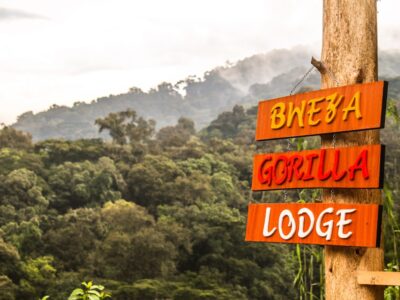
Bweza Gorilla Lodge
Rushaga Sector - Bwindi Impenetrable National ParkLocated high in the hills at the edge of the Bwindi Impenetrable Forest.

Four Gorillas Lodge
Rushaga Sector- Bwindi Impenetrable National ParkA Luxurious, elegant, romantic safari lodge nesteled on the peripheries of Bwindi Forest in the Rusjaga sector of Bwindi Impenetrable National Park

Ichumbi Gorilla Lodge
Ichumbi Gorilla Lodge provides Luxury Cottages, with en-suite facilities and a private balcony to enjoy the spectacular view of Bwindi ForestUt enim ad minim veniam, quis nostrud exercitation ullamco laboris nisi ut aliquip.
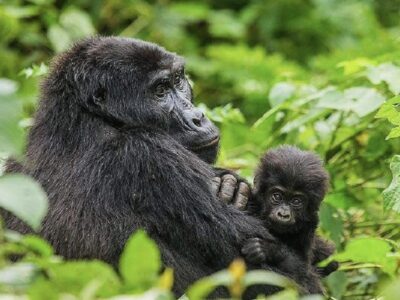
4 Days Gorillas in the Mist Fly-in Safari
Bwindi Impenetrable National ParkEncounter the endangered Mountain Gorillas in their natural habitat on this short 4 days Safari to Uganda.

